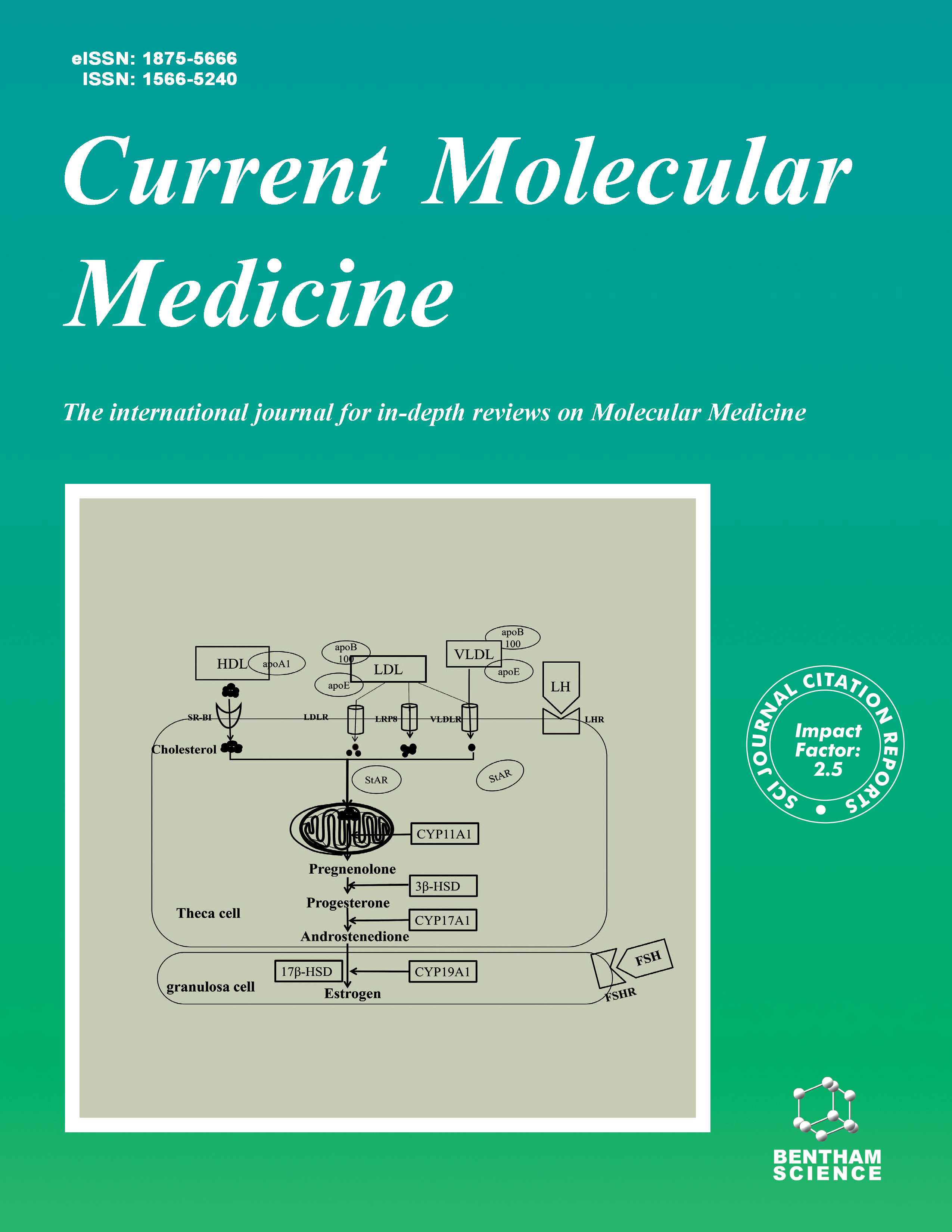- Home
- A-Z Publications
- Current Molecular Medicine
- Previous Issues
- Volume 23, Issue 4, 2023
Current Molecular Medicine - Volume 23, Issue 4, 2023
Volume 23, Issue 4, 2023
-
-
Hypoxia-Inducible Factors-Based Single Nucleotide Polymorphism in Breast Cancer with More Cancer Susceptibility
More LessAuthors: Suman K. Ray and Sukhes MukherjeeHypoxia-inducible factors (HIFs) are a collection of transcriptional factors that engage in the regulation of oxygen homeostasis. They are hypoxia-responsive stress factors whose expression is linked to tumor growth and angiogenesis. HIF is a crucial player in the progression of breast cancer. Patients with high levels of hypoxia-inducible HIFs in their primary tumor biopsies had a higher chance of metastasis, the leading cause o Read More
-
-
-
ORLNC1 Suppresses Cell Growth in HER2-Positive Breast Cancer via miRNA-296 Sponging
More LessAuthors: Xueyuan Cheng, Zhong Huang, Anchao Pan and Di LongBackground: Accumulating research has demonstrated that aberrant levels of long noncoding RNAs (LncRNAs) are related to cancer progression. The effects of ORLNC1 in HER2+ breast cancer have yet to be explored. Methods: Real-time PCR was used to examine the expression of LncRNA ORLNC1 in HER+ breast cancer. CCK-8, wound healing and cell invasion assays were used to examine the effect of LncRNA ORLNC1 on Read More
-
-
-
Piwi-interacting RNAs (piRNAs) and Colorectal Carcinoma: Emerging Non-invasive diagnostic Biomarkers with Potential Therapeutic Target Based Clinical Implications
More LessAuthors: Suman K. Ray and Sukhes MukherjeePIWI-interacting RNAs (piRNAs) constitute new small non-coding RNA molecules of around 24-31 nucleotides in length, mostly performing regulatory roles for the piwi protein family members. In recent times, developing evidence proposes that piRNAs are expressed in a tissue-specific way in various human tissues and act as moderate vital signalling pathways at the transcriptional or post-transcriptional level in addition Read More
-
-
-
Exosomal microRNAs: A Diagnostic and Therapeutic Small Bio-molecule in Esophageal Cancer
More LessAuthors: Mahshid Shahverdi and Maryam DarvishEsophageal cancer (EC) is one of the major causes of cancer-related death worldwide. EC is usually diagnosed at a late stage, and despite aggressive therapy, the five-year survival rate of patients remains poor. Exosomes play important roles in cancer biology. Indeed, exosomes are implicated in tumor proliferation, angiogenesis, and invasion. They contain bioactive molecules such as lipids, proteins, and non-coding Read More
-
-
-
The Role of Bone Morphogenetic Protein 4 in Lung Diseases
More LessAuthors: Xiaoxiao Dong, Yimin Mao and Pengfei GaoBone morphogenetic protein 4 (BMP4) is a multifunctional secretory protein that belongs to the transforming growth factor β superfamily. BMPs transduce their signaling to the cytoplasm by binding to membrane receptors of the serine/threonine kinase family, including BMP type I and type II receptors. BMP4 participates in various biological processes, such as embryonic development, epithelial-mesenchymal transition, and m Read More
-
-
-
Sperm Mitochondria, the Driving Force Behind Human Spermatozoa Activities: Its Functions and Dysfunctions - A Narrative Review
More LessBy Naina KumarMale infertility is a major issue, and numerous factors contribute to it. One of the important organelles involved in the functioning of human spermatozoa is mitochondria. There are 50-75 mitochondria helically arranged in mid-piece bearing one mitochondrial DNA each. Sperm mitochondria play a crucial role in sperm functions, including the energy production required for sperm motility and the production of re Read More
-
-
-
Potential Roles of 5-HT3 Receptor Antagonists in Reducing Chemotherapy-induced Peripheral Neuropathy (CIPN)
More Less5-HT3 receptor antagonists corresponding to ondansetron, granisetron, tropisetron, and palonosetron are clinically accustomed to treating nausea and emesis in chemotherapy patients. However, current and previous studies reveal novel potentials of those ligands in other diseases involving the nervous system, such as addiction, pruritus, and neurological disorders, such as anxiety, psychosis, nociception, and cognitive function. Read More
-
-
-
Mesenchymal Stem Cell-derived Exosomes Affect Macrophage Phenotype: A Cell-free Strategy for the Treatment of Skeletal Muscle Disorders
More LessAuthors: Gang Su, Xiaoting Lei, Zhenyu Wang, Weiqiang Xie, Donghong Wen and Yucheng WuThe process of tissue damage, repair, and regeneration in the skeletal muscle system involves complex inflammatory processes. Factors released in the inflammatory microenvironment can affect the phenotypic changes of macrophages, thereby changing the inflammatory process, making macrophages an important target for tissue repair treatment. Mesenchymal stem cells exert anti-inflammatory effects by regulating im Read More
-
-
-
Oxidative Damage by 3-nitrotyrosine in Young Adults with Obesity: Its Implication in Chronic and Contagious Diseases
More LessIntroduction: Cellular damage by oxidation occurs in numerous chronic diseases, such as obesity, type II diabetes, cardiovascular disease, nonalcoholic fatty liver, etc. The oxidized compound 3-nitrotyrosine is a marker of oxidative stress and protein oxidation damage. Objective: The article aims to assess whether 3-nitrotyrosine levels are higher in young people with obesity than in the same population without obesity. Read More
-
-
-
An Insight into the Role of E2F1 in Breast Cancer Progression, Drug Resistance, and Metastasis
More LessAuthors: Zafar A. Shah, Faisal Nouroz, Samina Ejaz and Asima TayyebAims: This study aimed to investigate the role of E2F1 in breast cancer biology. Background: Expression of E2F1, a transcription factor of many oncogenes and tumor suppressor genes, is lowered in several malignancies, including breast carcinoma. Objectives: In the present study, we analyzed the status of E2F1 expression in association with diverse attributes of breast malignancy and its impact on cancer progression. Read More
-
Volumes & issues
-
Volume 25 (2025)
-
Volume 24 (2024)
-
Volume 23 (2023)
-
Volume 22 (2022)
-
Volume 21 (2021)
-
Volume 20 (2020)
-
Volume 19 (2019)
-
Volume 18 (2018)
-
Volume 17 (2017)
-
Volume 16 (2016)
-
Volume 15 (2015)
-
Volume 14 (2014)
-
Volume 13 (2013)
-
Volume 12 (2012)
-
Volume 11 (2011)
-
Volume 10 (2010)
-
Volume 9 (2009)
-
Volume 8 (2008)
-
Volume 7 (2007)
-
Volume 6 (2006)
-
Volume 5 (2005)
-
Volume 4 (2004)
-
Volume 3 (2003)
-
Volume 2 (2002)
-
Volume 1 (2001)
Most Read This Month
Article
content/journals/cmm
Journal
10
5
false
en


